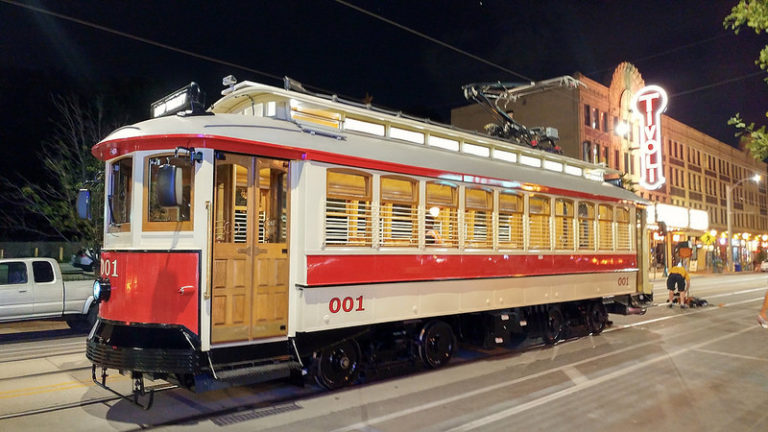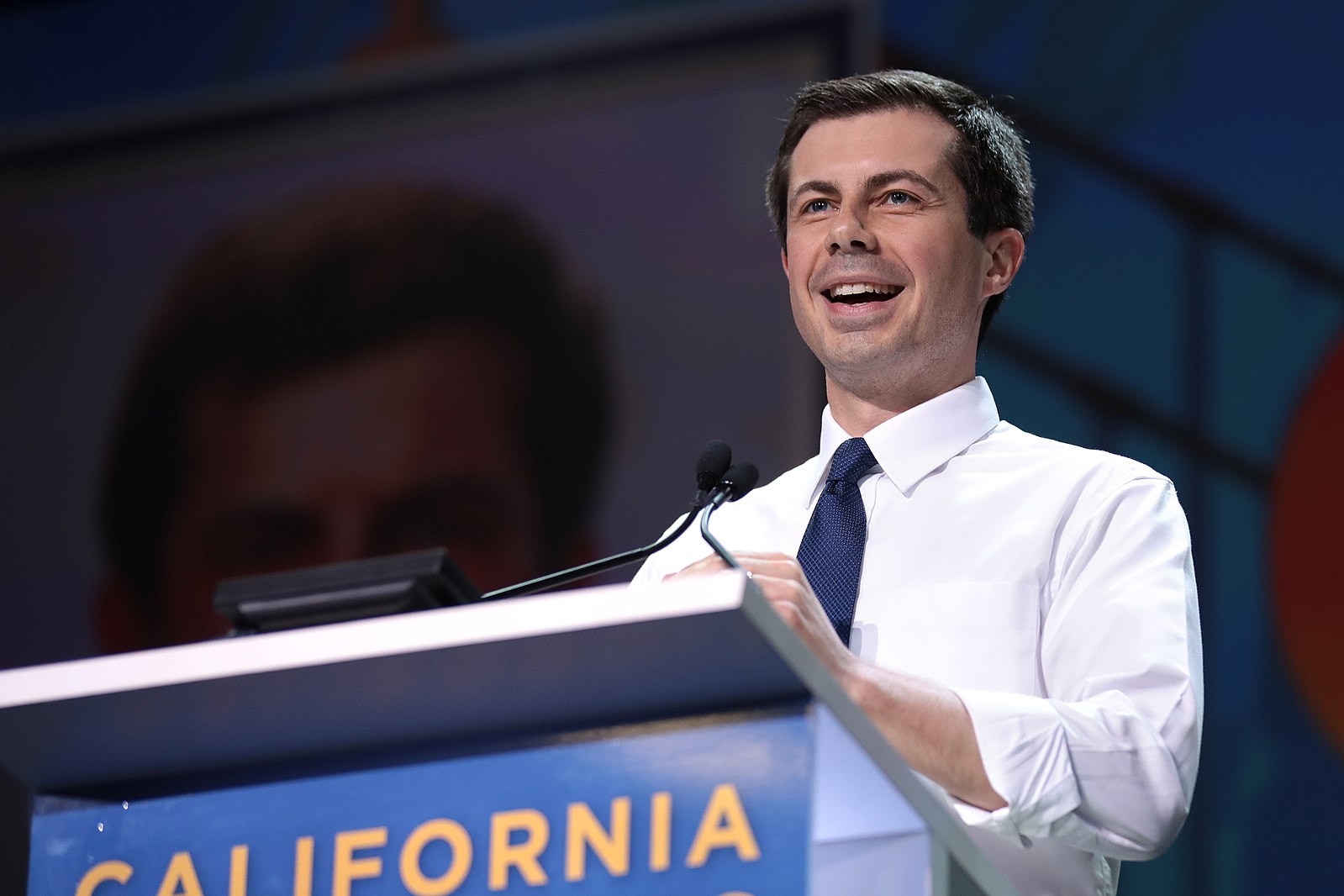St. Louis’s Tourist Trolley Gets a Lifeline — But Is That Good News?
8:53 AM EST on November 11, 2019

The Loop Trolley.
St. Louis's much-unloved, routinely mocked, and very expensive tourist trolley to nowhere just got a lifeline — a lifeline that may turn out to be a death sentence for other, much more crucial transit projects.
Just weeks after The Loop Trolley Company announced that it faced imminent closure unless it got an emergency injection of $700,000 from local government, the non-profit operator said the local transportation development district has agreed to fill the funding gap through Jan. 1, 2020.
In addition, Bi-State Development, the region’s transit planning body, will “explore a viable solution to continue the long-term operation,” Loop Trolley Board President John Meyer, Jr. said.
A potential management handoff may seem like a surprising move from a group that only started running trains 11 months ago. Then again, probably not. More and more St. Louisans are questioning the need for a redundant piece of transit that now looks like a boondoggle.
St. Louis County Councilman Tim Fitch is one such skeptic, having first called attention to the Loop Trolley’s request for a public bailout in an Oct. 12 tweet, noting that this is the third such request the nonprofit has made to cover construction and operating cost overruns in the five years since the project broke ground. The two previous requests of the council, totaling $3.7 million, were granted — but Fitch says it may be time to finally say no.
“The Loop Trolley project was, from day one, a tourism idea that they tried to sell as transportation so they could tap transportation funds,” he says. “That’s what this was always about.”
He’s not alone. Fellow Council Member Mark Harder called for a federal audit of the Trolley Company following their plea for emergency assistance, alleging potential misuse of the $33.9 million in federal transportation funding.
And local officials aren’t the only ones growing weary of the Trolley’s inability to sustain its own operations without emergency subsidies. Even self-described “pro-transit” citizens like local civil engineer Kaleena Menke see the Trolley’s funding woes as a potential blessing in disguise.
“I’m excited that [the] funding gap may finally put the nail in the trolley coffin,” she said. “We should just cut our losses and be done. It’s a perfect teachable moment for our region of the sunk cost fallacy. It’s time to pave over the gaps and move on.”
A $51-Million Boondoggle
So how did St. Louis — a city where 70 percent of surveyed citizens indicate they’d support increased transit funding — get to the point where many would see their newest rail line shuttered and $51-million in total project costs lost, rather than give it what might seem like a paltry 1.3 percent boost? The answer has to do, in part, with the atypical origins of the Trolley project itself.
The Trolley is the brainchild of Joe Edwards, the largest real estate developer in the Delmar Loop region that runs astride Washington University, and a local character famous for implementing his auteur-like vision on a district that had struggled to attract development.
Edwards’s dream is one replete with 1950s nostalgia, amusement park rides, and a few freaky holographs of his own face in the restaurants he owns. Some have referred to the trolley as his “vanity project”; Edwards first proposed the train way back in 1997, and helped to establish the non-profit Loop Trolley Company in 2001 to build public and governmental support for his vision.
Unlike Edwards’s private development ventures, though, the Trolley has been the recipient of generous public subsidy — a subsidy funded even by those members of the public who don’t buy into his kitschy vision for the district. Trolley funding was sourced primarily from Federal Transit Administration grants totaling $25 million, as well as local matching grants from city and county transportation budgets and a one-cent sales tax on businesses within their designated Transportation Development District.
When the tracks were actually laid, though, many St. Louisans questioned whether the project was worth the investment. The two-mile line connects two destinations, Forest Park and the Delmar Loop, that are already connected by the region’s light rail system, though the trolley offers a slightly more scenic route. Forest Park is a major public amenity comparable to New York’s Central Park, but it is not a job or housing center, and doesn’t help St. Louisans in need of transit alternatives to meet their daily necessities in the car-dominated city. The Delmar Loop is largely a shopping district running astride Washington University, and is otherwise dominated by student housing.
As a result, the Loop Trolley has struggled to attract riders since; fares totaled less than $23,000 in its first six months of operation. That’s just a reported 11,634 tickets.
Save the Trolley, but Lose the Transit Future?
Anemic ridership is one thing, but a sick transit future is another. The executive director of East-West Gateway, James Wild, told the St. Louis Post Dispatch that “it’s likely some of the [$25 million in FTA] funds would have to be repaid [if the Trolley fails]."
"We just have to determine how much that would be," he added. "We’re not sure if there is a precedent for this.”
One St. Louis city official, who preferred to remain anonymous, was concerned that even if the region didn’t have to repay the funds, the Trolley’s funding crisis could harm the region’s prospects for future federal transportation dollars — a funding source that’s especially crucial in a transit-unfriendly state like Missouri, whose statewide transit budget is a meager $1.7 million a year, split between 34 transit providers.
“There is the potential for it to be pretty bad for Metro, because this was an FTA grant, and Metro relies on FTA grant funding to keep operating the system,” the city official said. “It definitely harms future grant applications. If the region can’t spend $500,000 a year for a few years to keep this running, we might miss out on tens of millions of dollars of other funding from FTA.”
This same city official, though, sees a potential future for the Loop Trolley — as a tourism vehicle, drawing on regional tourism funds rather than transportation dollars.
“[The Loop Trolley Company] may need to be reconstituted with different ownership; maybe the Convention and Visitors’ Center,” the source said. “I mean, it’s there, it’s been built, the disruption happened, the money has been spent.”
The Loop Trolley Company itself seems to acknowledge that the line is probably best seen as an asset to the region’s tourism landscape. When asked why continued service to the Loop Trolley would be an asset to the transportation future of the St. Louis metro area, Loop Trolley Company Executive Director Kevin Barbeau replied, “The Loop Trolley attracts tourism on the Delmar Loop, surrounding neighborhoods and tourist attractions like Forest Park and the Central West End. Tourism dollars are important to St. Louis’s economic development, success and progress.”
In a Nov. 3 letter to the editor to the Post Dispatch, former Clayton, Mo. Mayor Ben Uchitelle also argued that the development of the trolley had correlated with increased infrastructure and development investment along the Loop as well.
“Without the development of the trolley, three major projects would not have occurred: the new safe roundabout at the University City lion gates; the new bridges on Delmar at the Wabash Station and on DeBaliviere over the Metro tracks; and the handsome new greenway down DeBaliviere from Delmar to Lindell,” Uchitelle argues. “[And] the Trolley project already has helped new developments, among them the new apartment tower and pharmacy at Delmar and Skinker.”
Economic development aside, it remains to be seen what the Trolley’s ongoing struggles will mean for the transportation future of the St. Louis region. And as the city and county continue to weigh the pros and cons of a bailout, Councilman Fitch said it’s time for St. Louisans to get involved.
“This Trolley project [was] standing basically with a gun to the head of the county council and saying, ‘give us this money or we’re going under on Nov. 15,” Fitch said. “It’s time for the public to weigh in.”
Read More:
Stay in touch
Sign up for our free newsletter
More from Streetsblog USA
Kiss Wednesday’s Headlines on the Bus
Bus-only lanes result in faster service that saves transit agencies money and helps riders get to work faster.
Four Things to Know About the Historic Automatic Emergency Braking Rule
The new automatic emergency braking rule is an important step forward for road safety — but don't expect it to save many lives on its own.
Who’s to Blame for Tuesday’s Headlines?
Are the people in this photo inherently "vulnerable", or is this car just dangerous?
Why Riders With Disabilities Have To Sue For Accessible Transit Stops
A Bay Area transit agency is only the latest to be sued over inaccessible stations. What will it take to get every American stop ADA compliant?
Monday’s Headlines Reconnect With Pete
More than $3 billion is flowing out of the White House to help correct infrastructure mistakes in Black communities.




